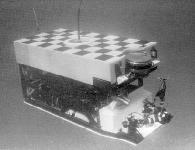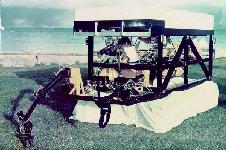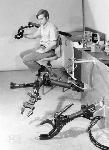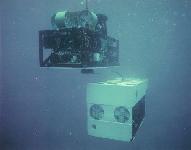





 The Remote Unmanned Work System (RUWS), precursor to the
Advanced Tethered Vehicle,
was designed to perform a variety of work tasks at ocean depths as
great as 20,000 feet (6100 m), giving it access to 98% of the ocean floor.
The Remote Unmanned Work System (RUWS), precursor to the
Advanced Tethered Vehicle,
was designed to perform a variety of work tasks at ocean depths as
great as 20,000 feet (6100 m), giving it access to 98% of the ocean floor.
 The work system itself included a hydraulically powered, master/slave
arm with seven functions including grip. The arm was terminus-controlled:
the operator moved a simple pistol grip to control the position and
orientation of the remote manipulator hand. It was also bilateral, or
force-feedback: weights and forces encountered by the remote arm were
reproduced at a scaled-down level in the master arm and thus felt by the
operator. A second four-function arm or gripper, simpler and more rugged, was
used to steady RUWS with respect to the work or work site.
The work system itself included a hydraulically powered, master/slave
arm with seven functions including grip. The arm was terminus-controlled:
the operator moved a simple pistol grip to control the position and
orientation of the remote manipulator hand. It was also bilateral, or
force-feedback: weights and forces encountered by the remote arm were
reproduced at a scaled-down level in the master arm and thus felt by the
operator. A second four-function arm or gripper, simpler and more rugged, was
used to steady RUWS with respect to the work or work site.
 The system actually consisted of two vehicles. The second was a heavy Primary
Cable Termination (PCT) to which the work vehicle was firmly attached during
deployment and recovery, and which carried a cable reel for
the 850 foot neutrally buoyant portion of tether. The functions of the PCT
were to maintain tension in the primary cable, provide position-keeping
capability to its bottom end, and to launch and recover the RUWS vehicle
itself. In affect, the PCT was a highly sophisticated plumbob, keeping the
main umbilical section vertical and isolating the RUWS from its motions.
The system actually consisted of two vehicles. The second was a heavy Primary
Cable Termination (PCT) to which the work vehicle was firmly attached during
deployment and recovery, and which carried a cable reel for
the 850 foot neutrally buoyant portion of tether. The functions of the PCT
were to maintain tension in the primary cable, provide position-keeping
capability to its bottom end, and to launch and recover the RUWS vehicle
itself. In affect, the PCT was a highly sophisticated plumbob, keeping the
main umbilical section vertical and isolating the RUWS from its motions.
 Another vital component of the system was the Motion Compensating Deck
Handling System (MCDHS), an extremely versatile combination of launch
crane and cable reel. Its purpose was to launch and recover the RUWS
vehicle/PCT combination and to tend the primary cable, minimizing
ship-induced motion and tension therein. It was capable of operating in sea
state three and recovery in sea state four.
Another vital component of the system was the Motion Compensating Deck
Handling System (MCDHS), an extremely versatile combination of launch
crane and cable reel. Its purpose was to launch and recover the RUWS
vehicle/PCT combination and to tend the primary cable, minimizing
ship-induced motion and tension therein. It was capable of operating in sea
state three and recovery in sea state four.
RUWS was lost at sea in January of 1980. The cause was determined to be a
design flaw in the mechanical attachment to the PCT. Search efforts proved
futile due to the extremely rough scarp bottom. RUWS is currently undergoing
what is termed "long-term corrosion tests" at 13,500 feet depth approximate 15
miles West of Kona, Hawaii.
